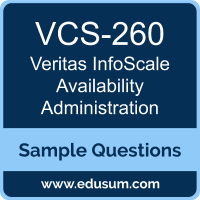01. Which scenario is supported when configuring applications for high availability in Azure cloud using InfoScale Enterprise?
a) Public access to cluster nodes in an Azure environment using a private IP
b) Failover across the subnet using an overlay IP
c) Secure access to cluster nodes in an Azure environment using a public IP
d) Failover within the same subnet using an overlay IP
02. What are two valid methods of notification from within Veritas Cluster Server?
(Select two.)
a) LOGGER
b) SMTP
c) SNMP
d) SYSTEMD
e) SYSLOGD
03. A parallel service group named websg is online on sym1, sym2, and sym3 in a three-node cluster. The service group contains a critical NIC resource and a non-critical Phantom resource.
If the network device specified in the NIC attribute fails on sym1, what is the resulting state for the websg service group?
a) faulted on sym1, online on sym2 and sym3
b) faulted on sym1, sym2, and sym3
c) offline on sym1, online on sym2 and sym3
d) partially online on sym1, online on sym2 and sym3
04. Which two should be considered when manually taking a service group offline with service group dependencies?
(Select two.)
a) For all soft dependencies, the child group can go offline regardless of the state of the parent group.
b) With firm dependencies, if the parent group is online, the child group offline is rejected.
c) For the online local hard dependency, if the parent group is online, the child group online is rejected.
d) The parent group offline is rejected only when the child group is online.
e) For hard dependencies, if the parent group goes offline, the child is taken offline automatically.
05. Why would an administrator want to configure preferred fencing in a multi-node cluster?
a) to specify which node wins the fencing race
b) to give preference to a node running a critical application
c) to identify which node should always be the RACER node
d) to specify how the fencing driver determines the surviving sub-cluster
06. An application identified for clustering by the system administrator is hard-coded so that it must be installed in /usr/local/app.
What are two considerations for clustering the application?
(Select two.)
a) The application could be clustered by mounting a file system from the shared storage on /usr/local/app.
b) The application is an inappropriate candidate to be clustered without creating a link to /opt/VRTSvcs.
c) The application could be clustered by creating a new directory under the root directory.
d) The application is an inappropriate candidate to be clustered without rewriting the source code.
e) The application could be clustered by creating a soft link from /usr/local/app to a shared file system.
07. In the event that all heartbeats are lost on all interfaces, what should be implemented to reduce the likelihood of a split brain condition?
a) configure AutoRestart for LLT
b) configure and enable postonline_ipc trigger
c) enable SCSI 2 disk reservation
d) configure I/O Fencing
08. Which method would be the most beneficial to protect the cluster when faced with intermittent network issues on the private heartbeat links?
a) implement the Quorum agent to protect heartbeat links
b) implement a low-priority heartbeat on the public NIC in the configuration
c) implement a Steward Process to watch the private heartbeats in the environment
d) implement a Virtual Business Service to provide arbitration across cluster nodes
09. At which two attribute levels can the TriggerPath attribute be set?
(Select two.)
a) cluster attribute
b) system attribute
c) service group attribute
d) resource attribute
e) resource type attribute
10. What occurs when an administrator runs the command hastop –all –force?
a) LLT and GAB are brought offline on all cluster nodes.
b) Applications are brought offline, and the cluster stops.
c) HAD and hashadow processes are stopped on all cluster nodes.
d) All applications are forcibly brought offline, but the cluster remains online.
 The purpose of this Sample Question Set is to provide you with information about the Administration of Veritas InfoScale Availability 7.3 for UNIX/Linux exam. These sample questions will make you very familiar with both the type and the difficulty level of the questions on the VCS-260 certification test. To get familiar with real exam environment, we suggest you try our Sample Veritas InfoScale Availability Administration Certification Practice Exam. This sample practice exam gives you the feeling of reality and is a clue to the questions asked in the actual Veritas Certified Specialist (VCS) - InfoScale Availability certification exam.
The purpose of this Sample Question Set is to provide you with information about the Administration of Veritas InfoScale Availability 7.3 for UNIX/Linux exam. These sample questions will make you very familiar with both the type and the difficulty level of the questions on the VCS-260 certification test. To get familiar with real exam environment, we suggest you try our Sample Veritas InfoScale Availability Administration Certification Practice Exam. This sample practice exam gives you the feeling of reality and is a clue to the questions asked in the actual Veritas Certified Specialist (VCS) - InfoScale Availability certification exam.